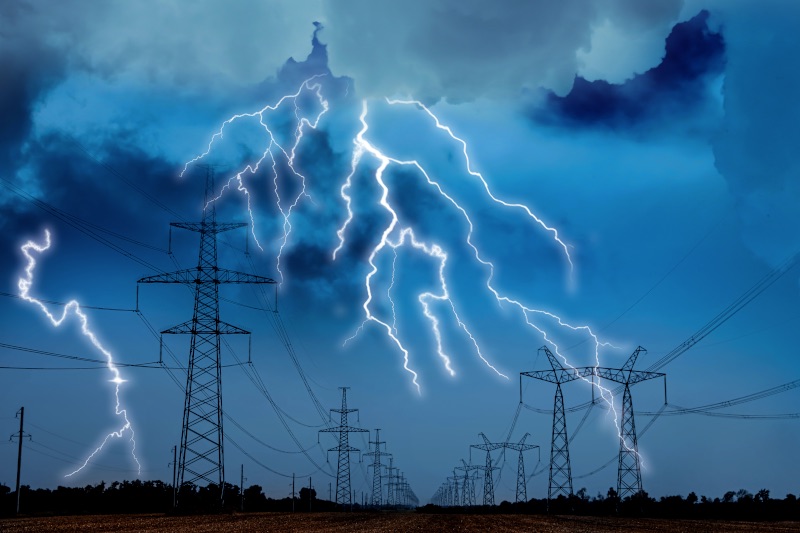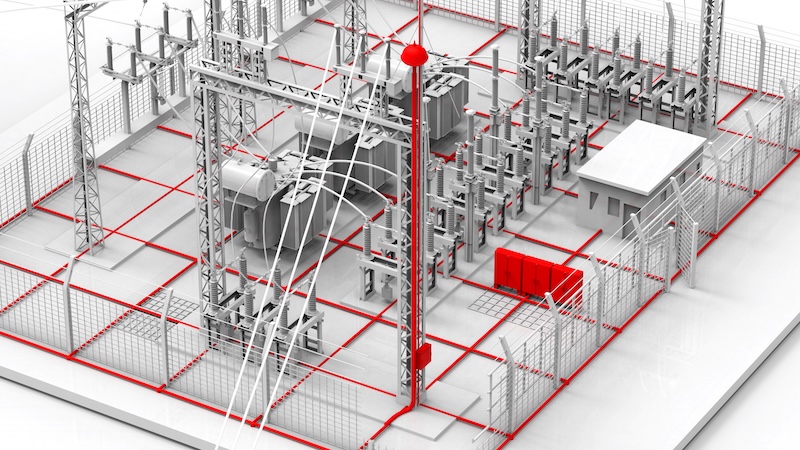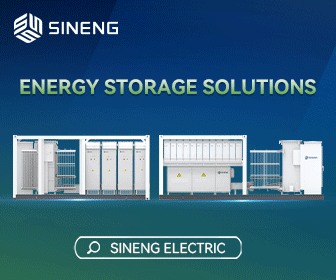Protecting Substations from Lightning
Natural disasters including hurricanes, severe storms, winter storms, wildfires and heat waves are becoming more frequent and severe, causing widespread power outages across the United States. Between 2000 and 2023, 80 percent of U.S. power outages were caused by weather events. Power outages caused by extreme weather can impact critical services like emergency response, hospitals, and communications networks. Energy storage on a utility level serves as a backup but relies on the health of the substation to deliver that much needed energy to consumers. Building more resilient energy systems that are equipped to handle the challenges of our modern world is essential, particularly as more and more systems come to rely on electricity.

One of the biggest threats to energy infrastructure is lightning. The substations that serve a critical purpose bringing power from transmission lines into communities, are particularly vulnerable. With their elevated metal construction, aerial wires, and high density of electrical equipment, these essential cogs for grid operations are practically lightning strike magnets.
Lightning creates incredibly powerful electric arcs up to and exceeding 200kA that can heat nearby equipment including buses, switching gear, circuit breakers, transformers, and auxiliary equipment such as carrier-current capacitors to dangerous temperatures, leading to electrical fires.
When lightning strikes it can damage equipment and instrumentation, disrupt service, and potentially cause injuries. While estimates vary, lightning strikes are responsible for up to 20 percent of all power outages in the U.S. and cause more than a billion dollars of property damage each year. In all cases, the potential financial losses stemming from severe transient events can be significant for utilities. While modern substations are designed to be resilient to lightning strikes, common standard protective measures often provide inadequate protection.
What can be done?
Passive lightning shielding systems are designed to protect a structure from a direct strike by providing a continuous path or discharge point for the current to the ground. They typically consist of masts, shield wires, and down conductors tied to a grounding system. Lightning arresters (surge arresters) are also used. These do not permit electrical flow under normal conditions but can change properties in response to a strike, becoming conductors rather than insulators to redirect excess electrical energy.

Protect substations from damage with a combination of lightning protection and grounding products
Substations generally rely on passive shielding systems to manage the millions of added volts a strike can generate. While these systems can divert the current safely away from electrical equipment, they do not actively react to an impending lightning strike.
Active shielding systems respond faster to a strike. These systems use sophisticated electronics and sensing equipment that monitor local electrical fields. When equipment senses an incoming strike, the electric field around the shielding system changes and it automatically activates to capture the current by presenting a “preferred point” for discharge. This essentially draws lightning strikes to a designated location where the current can be safely dispersed.
Active protection responds dynamically to the presence of lightning “downleaders” — the first indication of an approaching strike — and create charged “upstreamers” that attract the strike. This increases the probability that a strike inside the system’s area of protection will contact the system’s air terminal rather than the structure and be transferred safely to a grounded area.
Active systems can provide higher levels of protection and, in some instances, may be more cost-effective to install than passive systems as they eliminate the need for an array of steel shielding wires above the substation. Removing these overhead wires has a subsequent benefit to the utility, as in reality many of these shielding wires are aging and corroded and have the potential to fall into the station, causing even more damage and possible failures.
Best practices
Outside of lightning protection, there are several other best practices that grid operators need to make sure to follow to improve resiliency in the face of climate threats. First, using high-quality lugs and certified tools is essential. Lugs, which are connectors used to terminate and connect electrical cables, must be properly installed to maintain a secure and efficient electrical connection.
Certified tools, designed explicitly for crimping and securing lugs, ensure the connections are made with the correct pressure and precision, reducing the risk of loose connections, overheating, and potential electrical failures. By adhering to industry standards and using certified tools, installers can significantly enhance the durability and performance of electrical systems, ultimately contributing to a safer and more reliable power infrastructure.
All electrical systems also require proper surge protection and grounding. Current always flows through the path of the lowest impedance, and even the most well-designed electrical systems can be at risk from fault currents from lightning, equipment malfunctions, or surges from power sources.
Good grounding and bonding systems consider soil conditions, seasonal patterns, and other unique site differences. This improves safety for people working with and around electrical equipment while maintaining reliability. Utilities must follow best practices for proper bonding and grounding, considering site locations, soil resistivity levels, and corrosion levels. Based on these factors, different types of connections, such as mechanical, compression, or exothermic, may be required to ensure the grounding and bonding systems work effectively. Manufacturers need to find grounding and bonding partners to support them through a design process tailored to their site conditions.

For the best grounding and bonding results, consider the soil conditions
No matter the solutions they choose, grid operators have a responsibility to protect their workers and customers from extreme weather threats. It follows that protecting the means of delivering the very stored energy meant to enhance grid stability can be just as important. Following these best practices for lightning protection and grounding is a great place to start.
Dave Dong is Director of Vertical Growth at nVent, which provides a comprehensive portfolio of systems protection and electrical connections solutions dating back more than 100 years.
nVent | www.nvent.com
Author: Dave Dong
Volume: 2025 July/August










